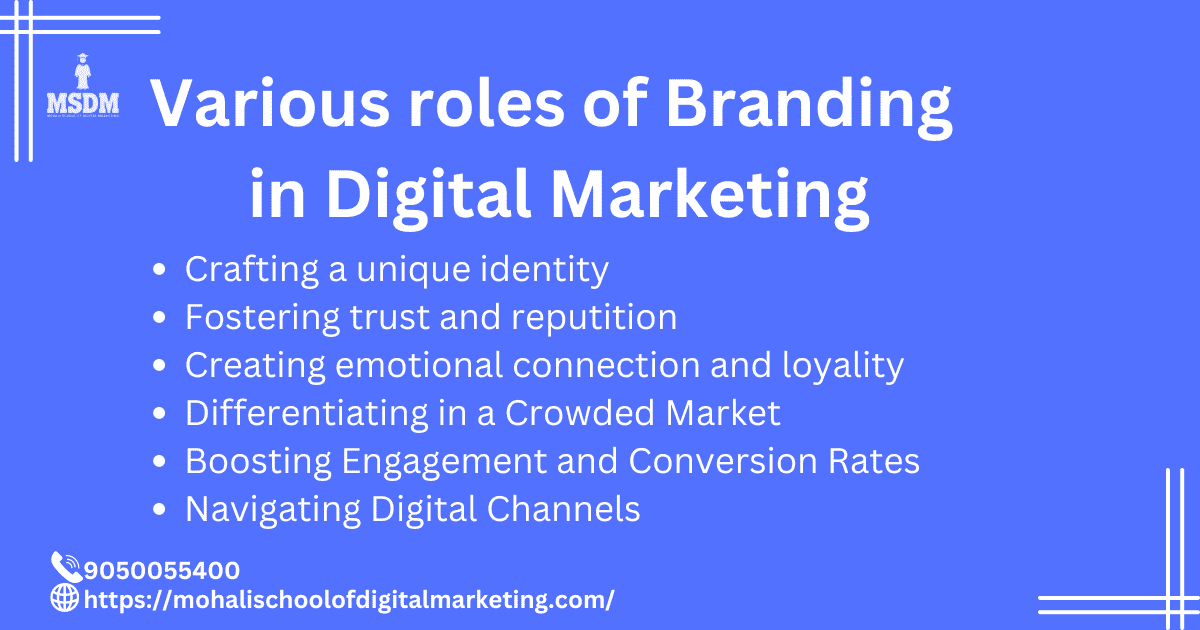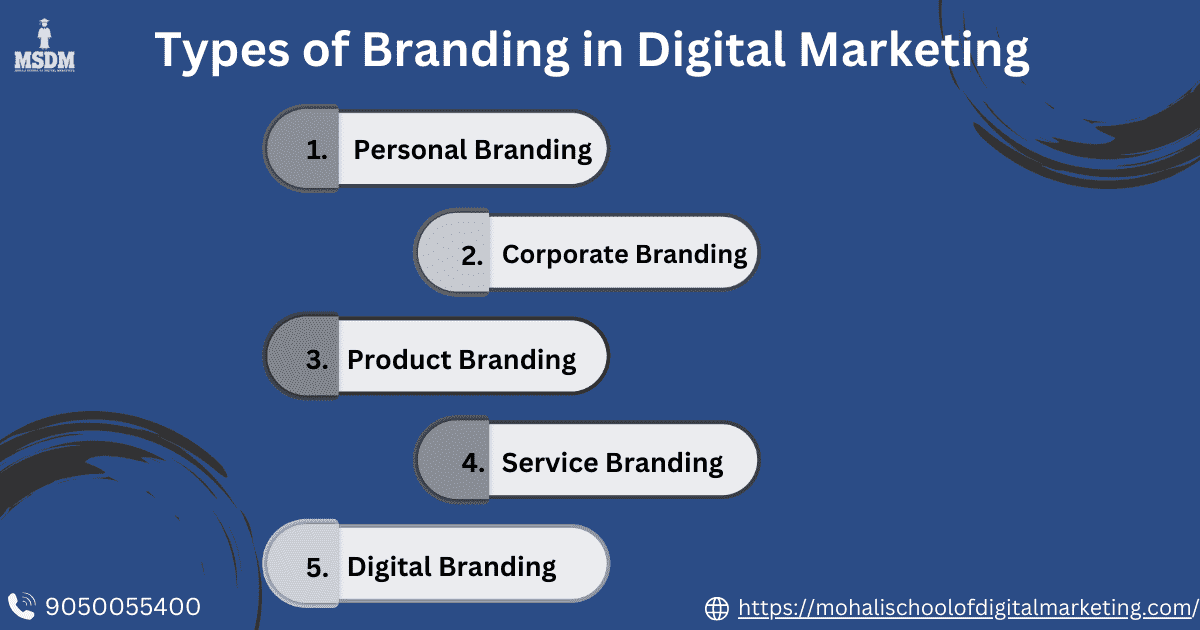
Introduction
Digital Marketing is the process of promoting goods, services, or brands to potential consumers by using digital channels, technologies. and platforms such as Instagram, Facebook, LinkedIn. In order to draw in, convert, and hold onto customers, it includes a variety of online strategies like social media, email, websites, search engines, and digital advertising. In the ever-changing world of digital marketing, where attention spans are fleeting and competition is intense, strong branding can be the key to success. Establishing a robust brand presence not only sets a business apart from its rivals but also plays a vital role in drawing in new clients. Let’s explore how branding impacts digital marketing strategies and aids in the acquisition of customers.
Various roles of branding in Digital Marketing

1. Crafting a Unique Identity
The foundation of branding starts with creating a unique identity that strikes a chord with your intended audience. In the digital marketing space, this identity is conveyed through a consistent use of logos, colors, typography, and messaging across various online platforms such as websites, social media, emails, and ads. A unified and memorable brand identity helps potential clients recognize and remember your business amidst the vast sea of online content.
2. Fostering Trust and Reputation
A powerful brand instills trust and confidence in consumers. In the digital world, where doubts about online businesses are common, a well-defined brand with a good reputation can ease these concerns and encourage purchases. Through consistent messaging, high-quality content, and engaging interactions, brands can build trust over time, making potential clients more likely to choose them over their competitors.
3. Creating Emotional Connections and Loyalty
Beyond its practical advantages, branding appeals to the emotions and goals of the intended recipient. . Digital marketing offers a wealth of opportunities to forge meaningful connections through storytelling, customer reviews, and interactive content. By aligning with the values and lifestyles of consumers, brands can create emotional ties that lead to long-term loyalty and advocacy. Customers who form emotional bonds with a brand often become brand advocates, naturally expanding the brand’s reach
4. Differentiating in a Crowded Market
In the current saturated digital market, differentiation is crucial.A considered brand strategy aids businesses in carving out a distinct market and differentiating themselves from competitors.. Whether it’s through innovative products, exceptional customer service, or a compelling brand narrative, brands that effectively communicate their unique selling points capture attention and spark interest among potential clients in search of solutions or experiences that resonate with them.
5. Boosting Engagement and Conversion Rates
Branding is essential in driving customer engagement and ultimately, in boosting conversion rates. A consistent brand presence across digital platforms enhances the user experience, guiding visitors smoothly from awareness to consideration and finally, to making a purchase. Brands may strengthen their message and boost conversion rates as customers move through the sales funnel by sticking to a consistent brand voice and visual identity throughout the customer journey.
6. Navigating Digital Channels
Digital marketing channels present unparalleled opportunities for brands to engage directly with their target audience. Social media platforms, in particular, enable brands to engage in real-time discussions, collect feedback, and respond quickly to customer inquiries. Effective utilization of these channels not only boosts brand visibility but also allows brands to humanize their interactions, building authenticity and trust along the way.
Types of branding in Digital Marketing

1. Personal Branding
Personal branding revolves around individuals establishing and promoting themselves online as a brand. It focuses on building a reputation, authority, and influence within a specific industry or niche.
Key Elements:
Identity: Establishing a unique persona that reflects expertise, values, and personality traits.
Content: Sharing insights, knowledge, and personal experiences through blogs, videos, social media posts, etc.
Consistency: Maintaining a consistent voice and appearance across all digital channels.
Engagement: Interacting with followers, responding to comments, and participating in industry conversations.
Purpose: Personal branding aims to attract opportunities such as speaking engagements, partnerships, consulting gigs, and career advancements by leveraging an individual’s credibility and influence.
2. Corporate Branding
Corporate branding focuses on establishing a cohesive identity and perception of a company across all digital platforms. It encompasses the overall brand image, values, mission, and visual elements.
Key Elements:
Brand Identity: Defining core values, mission statement, and brand promise.
Visual Identity: Consistent use of logos, colors, typography, and design elements across digital assets.
Messaging: Crafting a compelling brand story and consistent communication of brand values.
Customer Experience: Ensuring consistency in brand experience across all touchpoints, from website to customer service interactions.
Purpose: Corporate branding aims to build trust, credibility, and recognition among customers and stakeholders, thereby enhancing loyalty and differentiating the company in a competitive market.
3. Product Branding
Product branding focuses on promoting specific products or services offered by a company. It aims to differentiate products from competitors and create a distinct identity in the market.
Key Elements:
Product Positioning: Identifying unique selling points and benefits that appeal to target customers.
Brand Integration: Aligning product branding with the overall corporate brand identity.
Visual Representation: Designing product-specific logos, packaging, and digital assets.
Marketing Campaigns: Developing targeted campaigns to highlight product features and benefits through digital channels.
Purpose: Product branding aims to drive sales, increase market share, and build customer loyalty by effectively communicating the value and benefits of the product to the target audience.
4. Service Branding
Service branding is similar to product branding but focuses on promoting specific services offered by a company. It emphasizes the quality, reliability, and unique features of services to attract and retain customers.
Key Elements:
Service Differentiation: Highlighting unique features, benefits, and advantages of services over competitors.
Customer Testimonials: Establish credibility and trust by utilizing client comments and endorsements.
Online Presence: Optimizing service descriptions on the company website and promoting services through digital marketing channels.
Service Experience: Ensuring consistency in delivering exceptional service experiences to customers.
Purpose: Service branding aims to establish expertise, build trust, and attract potential clients by showcasing the company’s capabilities and commitment to delivering superior service.
5. Digital Marketing
Digital branding encompasses the overall online presence and perception of a brand across digital channels. It includes the management of websites, social media profiles, online reviews, and digital advertising campaigns.
Key Elements:
Online Reputation Management: Monitoring and responding to online reviews and customer feedback.
Social Media Management: Engaging with followers, sharing relevant content, and building a community around the brand.
Search engine optimization (SEO) and content marketing: It involve making material more visible and drawing in organic traffic.
Digital Advertising: Running targeted ad campaigns on platforms like Google Ads, Facebook Ads, and LinkedIn Ads.
Purpose: Digital branding aims to enhance brand visibility, engage with target audiences, drive website traffic, and ultimately, generate leads and conversions in the digital landscape.
Conclusion
To sum up, branding is the cornerstone around which effective digital marketing tactics are constructed. Brands may draw in new clients and cultivate enduring relationships by developing a unique identity, building trust, establishing emotional ties, and making good use of digital media. Investing in a strong brand helps businesses stand out in the increasingly competitive digital landscape while also ensuring continued growth and relevance in the eyes of customers.
Despite the challenges posed by digital marketing, branding continues to play a critical role in drawing customers in, encouraging interaction, and eventually producing significant business results. Through the strategic alignment of branding initiatives with digital marketing strategies, companies can foster a devoted clientele and attain enduring prosperity in the digital era. Get yourself enrolled at Mohali School of Digital Marketing, if you are into mastering digital marketing.
